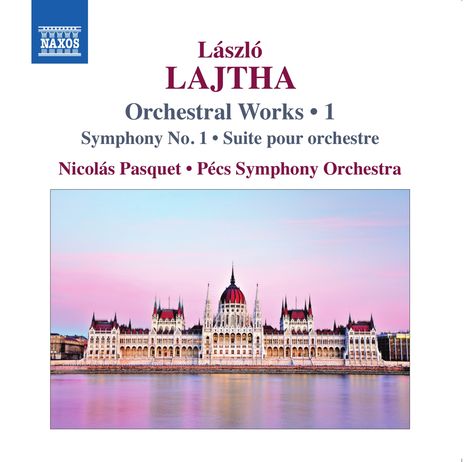Laszlo Lajtha: Symphonie Nr.1 auf CD
Symphonie Nr.1
Herkömmliche CD, die mit allen CD-Playern und Computerlaufwerken, aber auch mit den meisten SACD- oder Multiplayern abspielbar ist.
Lassen Sie sich über unseren eCourier benachrichtigen, falls das Produkt bestellt werden kann.
+Orchestersuite op. 19; In memoriam op. 35
- Künstler:
- Pecs Symphony Orchestra, Nicolas Pasquet
- Label:
- Naxos
- Aufnahmejahr ca.:
- 1996
- UPC/EAN:
- 0747313364374
- Erscheinungstermin:
- 9.9.2016
Obwohl es der Titel nicht so aussagt, hat der Komponist seine Suite pour orchestre, Opus 19, aus dem Ballett Lysistrata zusammengestellt. Lajtha schrieb für Werke für die Bühne, drei funkelnde Ballette und eine brillante komische Oper. Das erste davon war das 1933 komponierte Einakter-Ballett Lysistrata, das einzige derartige Werk Lajthas, das zu seinen Lebzeiten inszeniert wurde. Die Ballette Le bosquet des quatre Dieux ("Der Hain der vier Götter") von 1943 und das Capriccio - Marionettentheater von 1944 sind nur aus den aus ihrer Musik abgeleiteten Suiten bekannt, während die Oper Le chapeau bleu ("Der blaue Hut") mit einem Libretto von Salvador de Madariaga erst 1990 im Ungarischen Rundfunk uraufgeführt wurde und bis heute nicht auf die Bühne gekommen ist.
Die Sinfonien von Lajtha lassen sich in zwei Gruppen unterteilen. Chronologisch nah beieinander, aber inhaltlich stark unterschiedlich sind die kraftvolle und optimistische Erste Symphonie von 1936 und die dramatische und bedrohliche Zweite Symphonie von 1938, wobei letztere auf die Furcht hindeutet, die den Komponisten bei den Anzeichen des kommenden Krieges überkam. Nach einer Pause von zehn Jahren setzte er die Reihe fort, mit einer neuen Sinfonie alle zwei oder drei Jahre, bis 1961.
Die Sinfonie Nr. 1 wurde besonders vernachlässigt, und hier zeigt sich die Affinität des Komponisten zum lateinischen oder französischen Musikstil, die Beherrschung des westlichen Musikidioms und das Vertrauen in die ungarische Volksmusik. Er hatte bereits vor 1936 Erfahrungen mit Filmmusik, Ballett und Orchestersuiten für ein großes Orchester gesammelt. In der Sinfonie sind seine außergewöhnliche Begabung für Instrumentierung, der Reichtum seiner melodischen Erfindung und sein Humor präsent.
Product Information
Although it is not so indicated by the title, the composer compiled his Suite pour orchestre, Opus 19, from the ballet Lysistrata. Lajtha wrote for works for the stage, three sparkling ballets and a brilliant comic opera. The first of these was the one-act ballet Lysistrata, composed in 1933, the only such work of Lajtha’s to be staged in his life-time. The ballets Le bosquet des quatre Dieux (“The Grove of Four Gods”) of 1943 and the Capriccio - Puppet Show of 1944 are only known from the suites derived from their music, while the opera Le chapeau bleu (“The Blue Hat”), with a libretto by Salvador de Madariaga, had its first performance on Hungarian Radio as late as 1990 and has still not been staged.
Lajtha’s symphonies can be divided into two groups. Chronologically close but sharply different in contents are the vigorous and optimistic First Symphony of 1936 and the dramatic and ominous Second Symphony of 1938, the latter suggesting the dread that came over the composer at the signs of coming war. After a break of ten years, he continued the series, with a new symphony every two or three years, until 1961.
Symphony No. 1 has been particularly neglected and the composer’s affinity with the Latin or French spirit, mastery of Western musical idiom and reliance on Hungarian folk-music is here apparent. He had had earlier experience of writing for a large orchestra, with film music, ballet and orchestral suites before 1936. In the symphony his exceptional gift for instrumentation, the richness of his melodic invention and his humour are all present.
Disk 1 von 1 (CD)
Suite für Orchester op. 19
-
1 1. Prélude et hymne
-
2 2. Marche burlesque
-
3 3. Valse lente
-
4 4. Can-can
-
5 In memoriam op. 35
Sinfonie Nr. 1 op. 24
-
6 1. Allegro
-
7 2. Andante
-
8 3. Allegro molto
Mehr von Laszlo Lajtha
-
Laszlo LajthaSymphonie Nr.2CDVorheriger Preis EUR 14,99, reduziert um 0%Aktueller Preis: EUR 10,99
-
Laszlo LajthaSymphonien Nr.3 & 4CDAktueller Preis: EUR 14,99
-
Laszlo LajthaKlavierwerkeCDVorheriger Preis EUR 14,99, reduziert um 0%Aktueller Preis: EUR 4,99
-
Laszlo LajthaSymphonien Nr.5 & 6CDAktueller Preis: EUR 14,99








